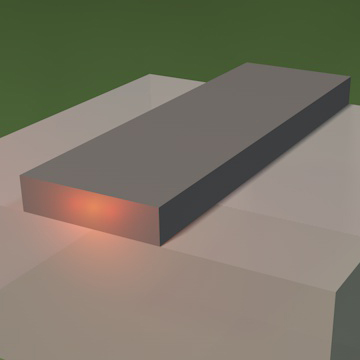Frequency combs in the molecular fingerprint region

When mid-infrared light is confined in a silicon nanowire, strongly nonlinear effects occur and broaden the spectrum of the seed laser light. Importantly, such effects preserve the comb structure of the input spectrum. Laser Spectroscopy Division, MPQ
In an article published in Nature Communications (February 20th, 2015), an international collaboration of scientists around Dr. Nathalie Picqué (Max-Planck Institute of Quantum Optics and Ludwig-Maximilians-Universität München) describes a reliable new technique of producing a broadband optical frequency comb in the mid-infrared region.
In a lithographically fabricated silicon nanowire waveguide, the spectrum of a short-pulse laser is significantly broadened. Even at low pulse energies, octave-spanning phase-coherent frequency combs are generated. The collaboration partners are with the University of Ghent (Belgium), the Interuniversity MicroElectronics Centre (Belgium), the University of Auckland (New Zealand) and the Institut des Sciences Moléculaires d’Orsay (France).
In the early 2000’s, the first extremely broad “supercontinum” spectrum was demonstrated by spectral broadening of short laser pulses in a micro-structured optical fibre. Supercontinuum generation finds important applications in photonic sciences, e.g in optical coherence tomography, optical communications or fluorescence microscopy.
Supercontinuum generation has also been a key to the realization of the first octave-spanning frequency combs. The spectrum of a frequency comb consists of a large number of discrete evenly spaced spectral lines. Such frequency combs enable precise measurement of optical frequencies as they allow a simple and direct comparison of optical frequencies with the radio frequency of an atomic clock.
In molecular spectroscopy all the comb lines may be simultaneously harnessed to rapidly measure complex, wide-band spectra with high sensitivity.
Today, frequency combs are commercially available in the visible and near-infrared spectral ranges. The mid-infrared spectral region (2-20μm), however, is still emerging. The region contains strong fundamental vibrational transitions of most molecules, as well as two atmospheric transmission windows. Therefore, the development of photonic technologies for this important spectral range is currently under active development.
Many applications in spectroscopy, material science, security and industry process control, or chemical, biological and medical sensing would straightforwardly take advantage of mid-infrared photonics devices of higher performance. In particular new strategies to mid-infrared frequency comb generation would strongly benefit molecular sciences. Unfortunately, the optical materials suitable for low-threshold octave-spanning phase-coherent spectral broadening remain scarce and difficult to engineer.
A team of scientists at MPQ has successfully explored a new way of generating mid-infrared frequency combs. The scientists used CMOS-compatible silicon nanophotonic waveguides on a silicon-on-insulator chip. Thanks to the high nonlinearity of the dispersion-engineered wires, they were able to record phase-coherent octave-spanning (1500–3300 nm) comb spectra.
In contrast to previous approaches, the waveguides are chemically stable. Even after several months, no modifications of the characteristics of the supercontinuum spectrum have been observed. With further system development, silicon technology has the potential to provide a room-temperature-operating platform for supercontinuum generation extending deeper in the mid-infrared, up to 8500 nm. On a longer term, such miniaturized wires could be part of on-chip frequency-comb spectrometers for chemical sensing.
Original publication:
B. Kuyken, T. Ideguchi, S. Holzner, M. Yan, T.W. Hänsch, J. Van Campenhout, P. Verheyen, S. Coen, F. Leo, R. Baets, G. Roelkens, N. Picqué
An octave-spanning mid-infrared frequency comb generated in a silicon nanophotonic wire waveguide
Nature Communications 6: 6310, DOI: http://dx.doi.org/10.1038/ncomms7310
February 20th, 2015.
Contact:
Dr. Nathalie Picqué
Max Planck Institute of Quantum Optics
Hans-Kopfermann-Str. 1, 85748 Garching, Germany
Phone: +49 (0)89 / 32 905 -290
E-mail: nathalie.picque@mpq.mpg.de
Dr. Olivia Meyer-Streng
Press & Public Relations
Max Planck Institute of Quantum Optics
Hans-Kopfermann-Str. 1, 85748 Garching, Germany
Phone: +49 (0)89 / 32 905 -213
E-mail: olivia.meyer-streng@mpq.mpg.de
Media Contact
More Information:
http://www.mpq.mpg.de/All latest news from the category: Physics and Astronomy
This area deals with the fundamental laws and building blocks of nature and how they interact, the properties and the behavior of matter, and research into space and time and their structures.
innovations-report provides in-depth reports and articles on subjects such as astrophysics, laser technologies, nuclear, quantum, particle and solid-state physics, nanotechnologies, planetary research and findings (Mars, Venus) and developments related to the Hubble Telescope.
Newest articles

Decoding Cancer: 40 Years of Breakthroughs in Genetic Research
Cancer in children and adolescents is rare. Nevertheless, malignant diseases are still one of the most common causes of death in this age group. Survivors of childhood or adolescent cancer…

Let’s Think Before the First Drink: How Early Substance Use Might Lead to Brain Structure Differences Among Adolescents
Many differences appeared to exist prior to any substance use, pointing to the role brain structure may play in substance use risk, NIH-supported study suggests. Studies reveal factors that expose…

Combating Kidney Cancer Using Enhanced Immunotherapies
Medical University of South Carolina Hollings Cancer Center researcher receives Department of Defense Early Career Scholar Award to improve immune therapies by targeting resistant kidney tumors. A Medical University of…



